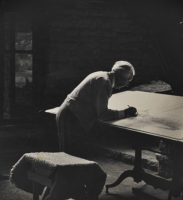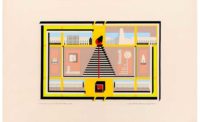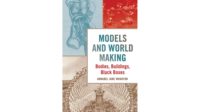For any architect familiar with the name Aldo Rossi, several images certainly come to mind: Rossi’s design for a tall, domed espresso pot, his floating Teatro del Mondo for the 1979-80 Venice Biennale, and the drawings, if not the buildings themselves, for the San Cataldo cemetery (1971-84), in Modena. These and more of the work of the Pritzker Prize-winning Italian architect appear in a new Princeton University School of Architecture exhibition, “Aldo Rossi: The Architecture and Art of the Analogous City,” curated by architectural historian Daniel Sherer. Perhaps the most ambitious exhibition at Princeton since architecture dean Monica Ponce de Leon established an active exhibitions program at the school in 2016, it is the first retrospective of Rossi’s work in the United States since 1976.
While relatively small given the span of Rossi’s productive career, Sherer’s show nonetheless packs a wallop: from the vivid blue end walls and elongated pedestal covered with drawings and objects in the main exhibition space to the many vitrines that spill into the school’s lobby, where Sherer displays books, magazines, and videos to contextualize Rossi’s career, including his role in the 1960s Italian Tendenza, which abandoned utopian modernism for critical and political realism in architecture.
Marking twenty years since the fatal 1997 car crash that took Rossi’s life, the exhibition might be seen by some as a further indication of the recent interest in postmodernism. While Rossi used simple geometries and a range of colors associated with postmodernism, he refused the postmodern label. “I cannot be postmodern because I’ve never been modern” is one of the Rossi quotations printed on the gallery walls, fitting textual displays for an architect also known for his books, The Architecture of the City (Italy, 1966, U.S. 1984) and A Scientific Autobiography (1981). In his books, essays, and buildings, as Sherer writes in the pamphlet that accompanies the show, “Rossi traced threads of memory that bind architecture to objects of daily life.” Similarly, Vincent Scully wrote in a postscript to A Scientific Autobiography, “[Rossi’s] forms are few precisely because they are not made up but remembered.” Those memories also became Rossi’s architectural analogies, seen in his endless repetition of coffee pots, geometric shapes, and beach cabanas that he gave architectural scale in drawings, etchings, and models.
Four clocks in the exhibition—a large, round wall clock, its silvery frame shiny against a blue wall, keeps Milan time; and three small clocks, each set into the pediment of a charming teatrino, all of them frozen—seem to symbolize tempo, the Italian word that Rossi, writing in Scientific Autobiography, said signifies “both atmosphere and chronology.” Through Sherer’s deft curation, time here is both stopped and moving—both memory and alive and spatial, recurring, like Rossi’s work itself.
In preparing the exhibition, Sherer relied in large part on the collection of Rossi material held by Gianni Braghieri, a Milan architect and Rossi’s former associate, as well as the private holdings of other former Rossi colleagues. These include etchings, paintings, drawings, models, and household objects, a range of materials that emphasizes Rossi’s focus on variations and repetition in what Sherer calls a pursuit of archetypes.
As architectural historian Kurt W. Forster wrote in 2008, over time Rossi’s objects have become “phantom vessels . . . launched on the ocean of architectural imagination. They make their appearance again and again.” In the current drive to produce new shapes and the seeming absence of memorable content, the opportunity to view Rossi again is a welcome repetition.
The exhibition runs through March 30, 2018, at the Princeton University School of Architecture.










Post a comment to this article
Report Abusive Comment